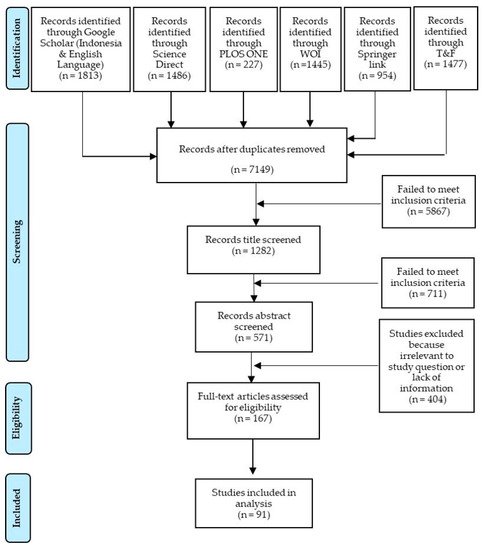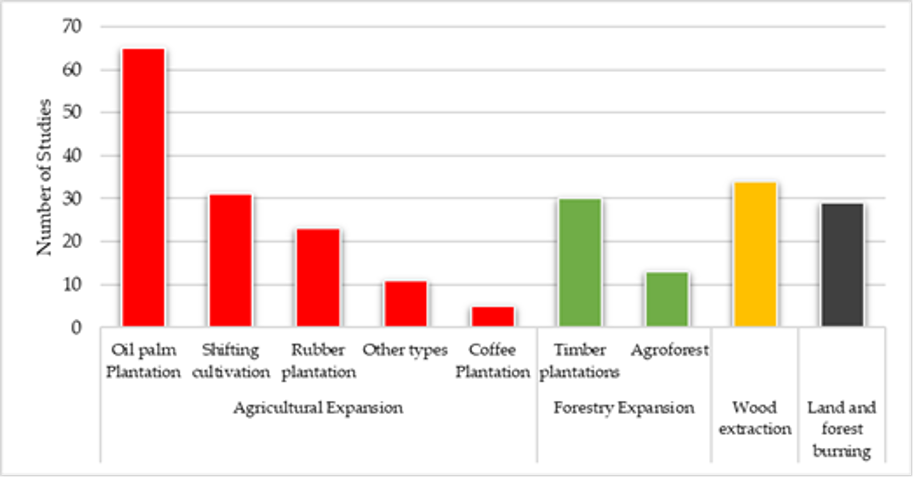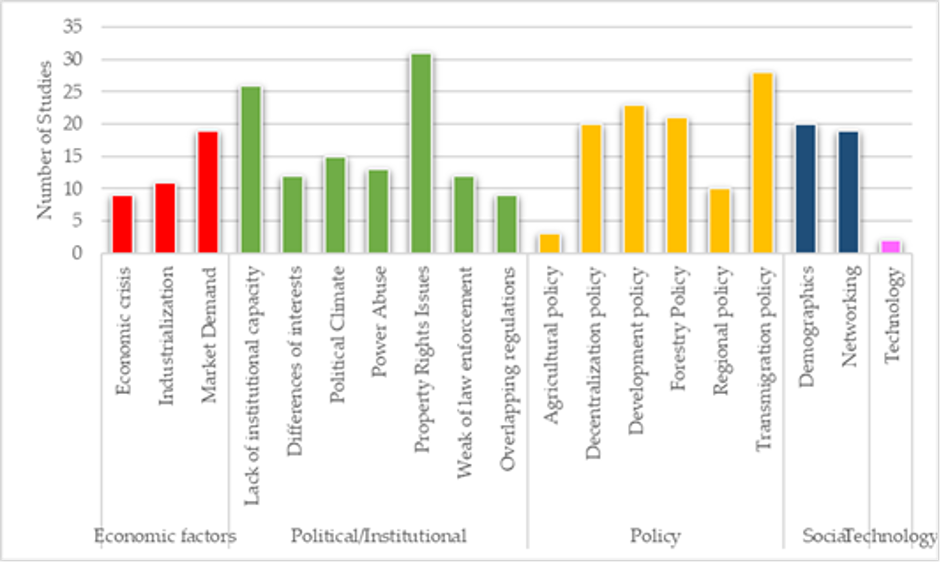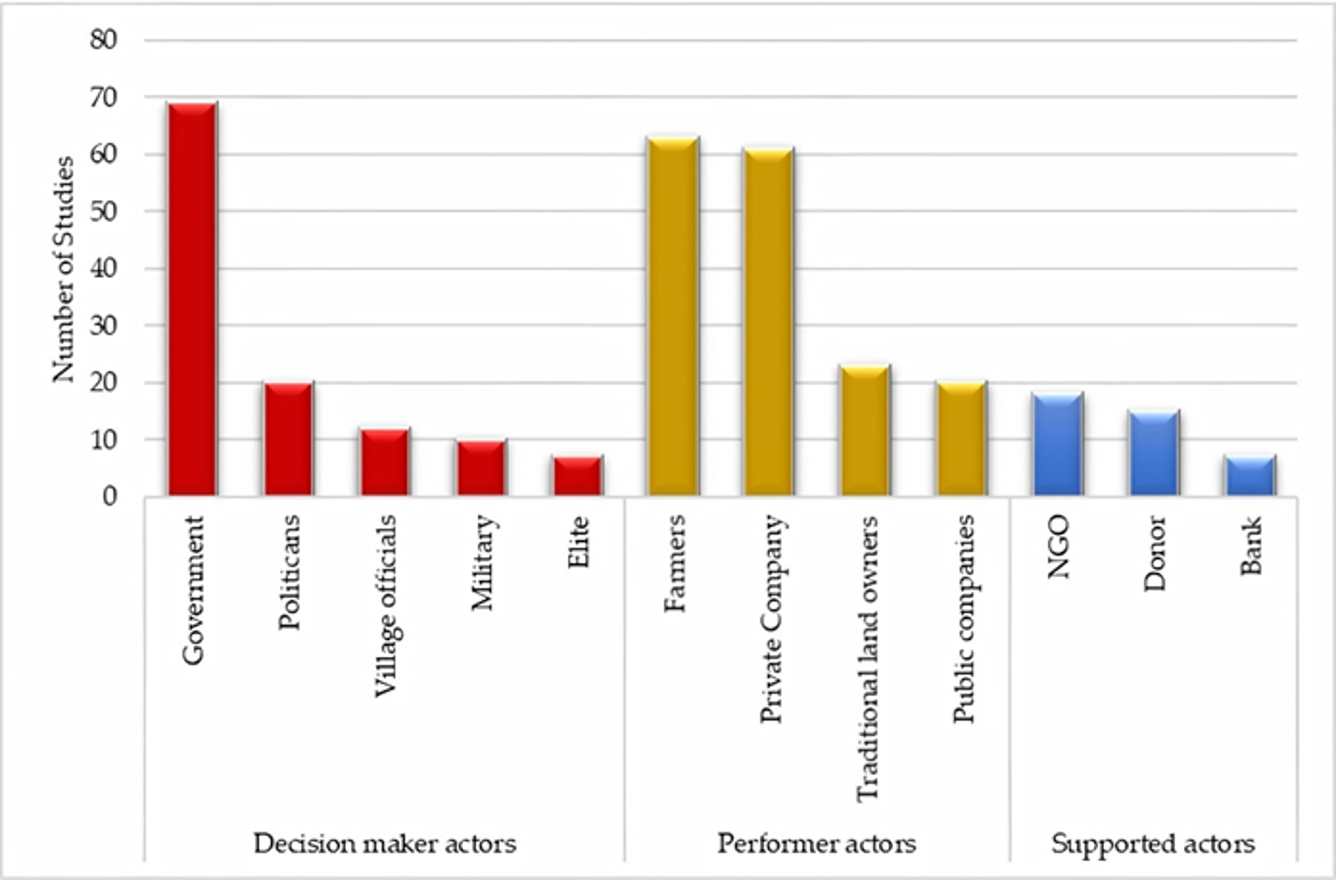
| Version | Summary | Created by | Modification | Content Size | Created at | Operation |
|---|---|---|---|---|---|---|
| 1 | Lila Juniyanti | + 4386 word(s) | 4386 | 2021-05-17 10:56:39 | | | |
| 2 | Lily Guo | Meta information modification | 4386 | 2021-05-24 03:47:44 | | |
Video Upload Options
Indonesia has experienced one of the world’s greatest dynamic land changes due to forestry and agricultural practices. Understanding the drivers behind these land changes remains challenging, partly because landscape research is spread across many domains and disciplines. Our review shows that oil palm expansion is the most prominent among multiple direct causes of land change. We determined that property rights are the most prominent issue among the multiple underlying causes of land change. Distinct combinations of mainly economic, institutional, political, and social underlying drivers determine land change, rather than single key drivers. Our review also shows that central and district governments as decision-making actors are prominent among multiple land change actors. Our systematic review indicates knowledge gaps that can be filled by clarifying the identification and role of actors in land change.
1. Introduction
2. Selection of the Articles

3. Agricultural and Forestry Practices as Direct Causes of Land Change
The diagram represents the sum of each sub-category of direct causes of land change in Sumatra and Kalimantan from the total studies analyzed (Figure 2). The expansion of agricultural areas has been by far the main direct cause of land change in Sumatra and Kalimantan. The activities that led to the most changes in the land were oil palm plantations (agricultural expansion sub-category) and wood extraction and timber plantations (forest expansion sub-category). Although shifting cultivation is not a dominant direct cause, shifting cultivation and wood extraction are distributed throughout the province. Oil palm and timber plantations that led to the most changes can be found in all provinces except North Kalimantan. North Kalimantan is a new province resulting from the division of East Kalimantan; thus, the direct causes of land change occurring in this region can be seen in the eastern province.
 Figure 2. Diagram of direct causes of land change in Sumatra and Kalimantan.
Figure 2. Diagram of direct causes of land change in Sumatra and Kalimantan.
The highest proportion of oil palm plantations are found in Riau Province (86.7%). Based on data from the Sub Directorate of Plantation Statistics in 2018, the total area of oil palm plantations in Riau represented Indonesia’s largest land-use type. The highest proportion of wood extraction operations are concentrated in the province of South Kalimantan (80%); this form of land use comprises wood extraction activities carried out by companies with forest concession rights (Hak Pengusahaan Hutan/HPH) or illegal logging by specific individuals. Agroforestry, coffee, and rubber plantations were the least important causes of land change. The highest proportions of agroforestry (19.5%) and rubber plantations (43.9%) were located in Jambi Province. The highest frequency for coffee plantation activities, 26.7%, can be found in studies located in Lampung.
Agriculture is the primary land use globally because half of the world’s habitable land is used for agriculture [5][31]. This condition shows that the leading direct causes of land change in Indonesia are the same as the global trend. This finding is also reinforced by several previous studies stating that the direct cause of land change in countries globally, including Indonesia, is agricultural expansion [8][13][32]. Oil palm is one of the most strategic commodities due to the high demand in various countries worldwide. Currently, Indonesia is the world’s largest palm oil producer [5], with an area of oil palm plantations in Indonesia to date reaching nearly 15 million hectares [33]. The plantation sector is also one of the largest contributors to gross domestic product (GDP), accounting for 0.29% amidst a GDP contraction rate of 5.32% [34].4. Institutional and Policy Factors as Underlying Causes of Land Change
 Figure 3. Diagram of underlying causes of land change in Sumatra and Kalimantan.
Figure 3. Diagram of underlying causes of land change in Sumatra and Kalimantan.5. The Most Prominent Actor in Land Change in Indonesia
 Figure 4. Diagram of land change actors in Sumatra and Kalimantan.
Figure 4. Diagram of land change actors in Sumatra and Kalimantan.6. Limitations and the Strength of the Study
7. The Future of Land Governance and Systematic Review Research
References
- Lambin, E.F.; Turner, B.L.; Geist, H.J.; Agbola, S.B.; Angelsen, A.; Folke, C.; Bruce, J.W.; Coomes, O.T.; Dirzo, R.; George, P.S.; et al. The Causes of Land-Use and Land-Cover Change: Moving beyond the Myths. Glob. Environ. Chang. 2001, 11, 261–269.
- Gatto, M.; Wollni, M.; Qaim, M. Land Use Policy Oil Palm Boom and Land-Use Dynamics in Indonesia: The Role of Policies and Socioeconomic Factors. Land Use Policy 2015, 46, 292–303.
- Lambin, E.F.; Geist, H.J.; Lepers, E. Dynamics of Land-Use and Land-Cover Chane in Tropical Regions. Annu. Rev. Environ. Resour. 2003, 205–241.
- Kindu, M.; Schneider, T.; Teketay, D.; Knoke, T. Science of the Total Environment Changes of Ecosystem Service Values in Response to Land Use/Land Cover Dynamics in Munessa—Shashemene Landscape of the Ethiopian Highlands. Sci. Total Environ. 2016, 547, 137–147.
- FAOSTAT. FAOSTAT Statistical Database; FAOSTAT: Rome, Italy, 2020.
- Marlier, M.E.; Defries, R.; Pennington, D.; Nelson, E. Future Fire Emissions Associated with Projected Land Use Change in Sumatra. Glob. Chang. Biol. 2015, 21, 345–362.
- Wicke, B.; Sikkema, R.; Dornburg, V.; Faaij, A. Exploring Land Use Changes and the Role of Palm Oil Production in Indonesia and Malaysia. Land Use Policy 2011, 28, 193–206.
- Geist, H.J.; Lambin, E.F. Proximate Causes and Underlying Driving Forces of Tropical Deforestation. Bioscience 2002, 52, 143–150.
- Hersperger, A.M.; Gennaio, M.; Verburg, P.H. Linking Land Change with Driving Forces and Actors: Four Conceptual. Ecol. Soc. 2010, 15, 1–17.
- Contreras-Hermosilla, A. The Underlying Causes of Forest Decline; Center for International Forestry Research: Bogor, Indonesia, 2000; Volume 30.
- Walker, R. Theorizing Land-Cover and Land-Use Change: The Case of Tropical Deforestation. Int. Reg. Sci. Rev. 2004, 27, 247–270.
- McCarthy, J.F. Processes of Inclusion and Adverse Incorporation: Oil Palm and Agrarian Change in Sumatra, Indonesia. J. Peasant Stud. 2010, 37, 821–850.
- Van Asselen, S.; Verburg, P.H.; Vermaat, J.E.; Janse, J.H. Drivers of Wetland Conversion: A Global Meta-Analysis. PLoS ONE 2013, 8.
- Abood, S.A.; Lee, J.S.H.; Burivalova, Z.; Garcia-Ulloa, J.; Koh, L.P. Relative Contributions of the Logging, Fiber, Oil Palm, and Mining Industries to Forest Loss in Indonesia. Conserv. Lett. 2015, 8, 58–67.
- Durand-Lasserve, A.; Royston, L. Holding Their Ground: Secure Land Tenure for the Urban Poor in Developing Countries; Earthscan Publications Ltd.: London, UK, 2002.
- Morrison, E.; Dubois, O. Sustainable Livelihoods in Upland Vietnam: Land Allocation and Beyond; International Institute for Environment and Development: London, UK, 1998.
- Bohnet, I.C.; Roebeling, P.C.; Williams, K.J.; Holzworth, D.; van Grieken, M.E.; Pert, P.L.; Kroon, F.J.; Westcott, D.A.; Brodie, J. Landscapes Toolkit: An Integrated Modelling Framework to Assist Stakeholders in Exploring Options for Sustainable Landscape Development. Landsc. Ecol. 2011, 26, 1179.
- Gough, D.; Oliver, S.; Thomas, J. An Introduction to Systematic Reviews; SAGE Publications Ltd.: London, UK, 2017.
- Bürgi, M.; Hersperger, A.M.; Schneeberger, N. Driving Forces of Landscape Change—Current and New Directions. Landsc. Ecol. 2004, 19, 857–868.
- Plieninger, T.; Bieling, C.; Kizos, T.; Martin, M.G. Pan-European Systematic Review and Meta-Analysis; HERCULES: Berlin, Germany, 2014.
- Rudel, T.K. Meta-Analyses of Case Studies: A Method for Studying Regional and Global Environmental Change. Glob. Environ. Chang. 2008, 18, 18–25.
- Reed, J.; van Vianen, J.; Barlow, J.; Sunderland, T. Land Use Policy Have Integrated Landscape Approaches Reconciled Societal and Environmental Issues in the Tropics? Land Use Policy 2017, 63, 481–492.
- Wehkamp, J.; Koch, N.; Lübbers, S.; Fuss, S. Governance and Deforestation—A Meta-Analysis in Economics. Ecol. Econ. 2018, 144, 214–227.
- Hunter, R.F.; Cleland, C.; Cleary, A.; Droomers, M.; Wheeler, B.W.; Sinnett, D.; Nieuwenhuijsen, M.J.; Braubach, M. Environmental, Health, Wellbeing, Social and Equity Effects of Urban Green Space Interventions: A Meta-Narrative Evidence Synthesis. Environ. Int. 2019, 130, 104923.
- Higgins, D.; Balint, T.; Liversage, H.; Winters, P. Investigating the Impacts of Increased Rural Land Tenure Security: A Systematic Review of the Evidence. J. Rural Stud. 2018, 61, 34–62.
- Keys, E.; Mcconnell, W.J. Meta-Analysis of Agricultural Change in the Tropics Global Change and the Intensification of Agriculture in the Tropics. Glob. Environ. Chang. 2016, 15, 320–337.
- Mantyka-Pringle, C.S.; Martin, T.G.; Rhodes, J.R. Interactions between Climate and Habitat Loss Effects on Biodiversity: A Systematic Review and Meta-Analysis. Glob. Chang. Biol. 2012, 18, 1239–1252.
- Seto, K.C.; Fragkias, M.; Guneralp, B.; Reilly, M.K. A Meta-Analysis of Global Urban Land Expansion. PLoS ONE 2011, 6, 1–9.
- Margono, B.A.; Turubanova, S.; Zhuravleva, I.; Potapov, P.; Tyukavina, A. Mapping and Monitoring Deforestation and Forest Degradation in Sumatra (Indonesia) Using Landsat Time Series Data Sets from 1990 to 2010. Environ. Commun. J. Nat. Cult. 2012, 7, 034010.
- Xiao, Y.; Watson, M. Guidance on Conducting a Systematic Literature Review. J. Plan. Educ. Res. 2019, 39, 93–112.
- Sandker, M.; Suwarno, A.; Campbell, B.M. Will Forests Remain in the Face of Oil Palm Expansion? Simulating Change in Malinau, Indonesia. Ecol. Soc. 2007, 12, 1–37.
- Prabowo, D.; Maryudi, A.; Senawi; Imron, M.A. Conversion of Forests into Oil Palm Plantations in West Kalimantan, Indonesia: Insights from Actors’ Power and Its Dynamics. For. Policy Econ. 2017, 78, 32–39.
- Directorate General of Estates. Tree Crop Estate Statistic of Indonesia 2018–2020; Ministry of Agriculture: Jakarta, Indonesia, 2020.
- Badan Pusat Statistik. Pertumbuhan Ekonomi Indonesia Triwulan III-2020; BPS: Jakarta, Indonesia, 2020.
- Hariyadi, B.; Ticktin, T. From Shifting Cultivation to Cinnamon Agroforestry: Changing Agricultural Practices Among the Serampas in the Kerinci Seblat National Park, Indonesia. Hum. Ecol. 2012, 40, 315–325.
- Directorate General of Estate Crops. Tree Crop Estate Statistics of Indonesia 2018–2020: Rubber; Ministry of Agriculture: Jakarta, Indonesia, 2019.
- Suyanto, S.; Applegate, G.; Permana, R.P.; Khususiyah, N.; Kurniawan, I. The Role of Fire in Changing Land Use and Livelihoods in Riau-Sumatra. Ecol. Soc. 2004, 9, 15.
- Linkie, M.; Smith, R.J.; Leader-Williams, N. Mapping and Predicting Deforestation Patterns in the Lowlands of Sumatra. Biodivers. Conserv. 2004, 13, 1809–1818.
- Lamb, D. Reforestation, Conservation and Livelihoods. In Regreening the Bare Hills: Tropical Forest Restoration in the Asia-Pacific Region; Springer: Dordrecht, The Netherlands, 2011; pp. 93–134.
- Casson, A.; Obidzinski, K. From New Order to Regional Autonomy: Shifting Dynamics of ‘Illegal’ Logging in Kalimantan, Indonesia. World Dev. 2002, 30, 2133–2151.
- Warman, R.D. Global Wood Production from Natural Forests Has Peaked. Biodivers. Conserv. 2014, 23, 1063–1078.
- FAO Statistics. Forest Products 2018; Food and Griculture Organization of the United Nations: Rome, Italy, 2020.
- Obidzinski, K.; Chaudhury, M. Transition to Timber Plantation Based Forestry in Indonesia: Towards a Feasible New Policy. Int. For. Rev. 2009, 11, 79–87.
- Lambin, E.F.; Geist, H.J. Regional Differences in Tropical Deforestation. Environ. Sci. Policy Sustain. Dev. 2003, 45, 22–36.
- Peluso, N.L. Hutan Kaya, Rakyat Melarat: Penguasaan Sumber Daya Dan Perlawanan Di Jawa; Khopalindo: Yogyakarta, Indonesia, 2006.
- Maryudi, A. The Contesting Aspirations in the Forests: Actors, Interests and Power in Community Forestry in Java; Universitätsdrucke Göttingen: Göttingen, Germany, 2011.
- Galudra, G.; Van Noordwijk, M.; Agung, P.; Suyanto, S.; Pradhan, U. Migrants, Land Markets and Carbon Emissions in Jambi, Indonesia: Land Tenure Change and the Prospect of Emission Reduction. Mitig. Adapt. Strateg. Glob. Chang. 2014, 19, 715–731.
- Sahide, M.A.K.; Giessen, L. The Fragmented Land Use Administration in Indonesia—Analysing Bureaucratic Responsibilities Influencing Tropical Rainforest Transformation Systems. L. Use Policy 2015, 43, 96–110.
- Indrabudi, H.; De Gier, A.; Fresco, L.O. Deforestation and Its Driving Forces: A Case Study of Riam Kanan Watershed, Indonesia. L. Degrad. Dev. 1998, 9, 311–322.
- Handayani, T. Legalitas Surat Keterangan Tanah Yang Dikeluarkan Oleh Kepala Desa Sebagai Dasar Transaksi Jual Beli Tanah; North Sumatera University: Medan, Indonesia, 2016.
- Intan, D.G. Penyelesaian Konflik Pertanahan Di Provinsi Lampung. Keadilan Progresif 2011, 2, 184–195.
- Khan, A.; Nugroho, B.; Suharjito, D.; Darusman, D.; VZuhud, E.A.; Hardjanto; Kartodihardjo, H.; Hendrayanto; Shohibudin, M.; Sardjono, M.A.; et al. Masalah Cara Pikir Dan Praktek Kehutanan: Refleksi Dan Evaluasi II. In Kembali ke Jalan Lurus: Kritik Penggunaan Ilmu dan Praktik Kehutanan Indonesia; Kartodihardjo, H., Ed.; FORCI Development dan Tanah Air Beta: Yogyakarta, Indonesia, 2013; p. 504.
- Li, T.M. Intergenerational Displacement in Indonesia’s Oil Palm Plantation Zone. J. Peasant Stud. 2017, 1–19.
- Kartodihardjo, H. Analisis Kebijakan Pengelolaan Sumber Daya Alam; Firdaus Pressindo: Yogyakarta, Indonesia, 2017.
- Miyamoto, M. Forest Conversion to Rubber around Sumatran Villages in Indonesia: Comparing the Impacts of Road Construction, Transmigration Projects and Population. For. Policy Econ. 2006, 9, 1–12.
- Imbernon, J. Changes in Agricultural Practice and Landscape over a 60-Year Period in North Lampung, Sumatra. Agric. Ecosyst. Environ. 1999, 76, 61–66.
- Feintrenie, L.; Chong, W.K.; Levang, P. Why Do Farmers Prefer Oil Palm? Lessons Learnt from Bungo District, Indonesia. Small-scale For. 2010, 9, 379–396.
- Rist, L.; Feintrenie, L.; Levang, P. The Livelihood Impacts of Oil Palm: Smallholders in Indonesia. Biodivers. Conserv. 2010, 19, 1009–1024.
- Tsujino, R.; Yumoto, T.; Kitamura, S.; Djamaluddin, I.; Darnaedi, D. History of Forest Loss and Degradation in Indonesia. Land Use Policy 2016, 57, 335–347.
- Juniyanti, L.; Prasetyo, L.B.; Aprianto, D.P.; Purnomo, H.; Kartodihardjo, H. Land-Use/Land Cover Change and Its Causes in Bengkalis Island, Riau Province (from 1990-2019). J. Nat. Resour. Environ. Manag. 2020, 10, 419–434.
- Brockhaus, M.; Obidzinski, K.; Dermawan, A.; Laumonier, Y.; Luttrell, C. An Overview of Forest and Land Allocation Policies in Indonesia: Is the Current Framework Sufficient to Meet the Needs of REDD+? For. Policy Econ. 2012, 18 (Suppl. C), 30–37.
- Wibowo, L.R.; Hakim, I.; Komarudin, H.; Kurniasari, D.R.; Wicaksono, D.; Okarda, B. Penyelesaian Tenurial Perkebunan Kelapa Sawit Di Kawasan Hutan Untuk Kepastian Investasi Dan Keadilan; Working Paper; 247; CIFOR: Bogor, Indonesia, 2019.
- Feintrenie, L.; Levang, P. Sumatra’s Rubber Agroforests: Advent, Rise and Fall of a Sustainable Cropping System. Small-Scale For. 2009, 8, 323–335.
- Villamor, G.B.; Pontius, R.G.; van Noordwijk, M. Agroforest’s Growing Role in Reducing Carbon Losses from Jambi (Sumatra), Indonesia. Reg. Environ. Chang. 2014, 14, 825–834.
- Potter, L. Resource Periphery, Corridor, Heartland: Contesting Land Use in the Kalimantan/Malaysia Borderlands. Asia Pacific Viewp. 2009, 50, 88–106.
- McCarthy, J.F. Changing to Gray: Decentralization and the Emergence of Volatile Socio-Legal Configurations in Central Kalimantan, Indonesia. World Dev. 2004, 32, 1199–1223.




